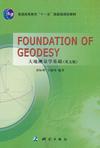大地测量学基础
2011-6
郭际明、 王建国 测绘出版社 (2011-06出版)
郭际明,王建国 著
117
《普通高等教育“十一五”国家级规划教材:大地侧量学基础(英文版)》是普通高等教育“十一五”国家级规划教材,专门为测绘工程专业必修课《大地测量学基础》双语教学编写,以系统讲授大地测量学的专业知识为主,结合作者多年的国外教学工作经验,按照国际化的课程设置和教学体系进行组织和规划,强调大地测量学的基本概念、基础理论、主要观测方法和数据归化方法,以及大地测量计算和大地测量国际组织等。 《普通高等教育“十一五”国家级规划教材:大地侧量学基础(英文版)》可作为普通高等教育测绘工程专业的教材,也可作为遥感科学与技术、地理信息系统专业的教学参考书。
Chapter 1 Introduction1.1 Definition and Classification of Geodesy1.2 Task of Geodesy1.3 Historical Development of GeodesyReview QuestionsChapter 2 Coordinate Systems and Time Systems2.1 Earth and Its Motions2.2 Time Systems2.3 Coordinate Reference SystemsReview QuestionsChapter 3 Gravity Field of the Earth3.1 Gravitation, Centrifugal Force and Gravity3.2 Gravitational Centrifugal and Gravity Potential3.3 Level Surfaces and Plumb Lines3.4 Spherical Harmonic Expansion of Gravitational Potential3.5 Normal Gravity and Its PotentialReview QuestionsChapter 4 Geodetic Calculation on Ellipsoid4.1 Meridian and Its Radius of Curvature4.2 Equator and Parallel Circle4.3 Prime Vertical4.4 Normal Arc4.5 Geodesic4.6 Length of Arc for Meridian and Parallel Circle4.7 Reduction of Directions and Distances from Natural Surface to Ellipsoid Surface4.8 Direct and Inverse Problem of GeodesicReview Questions Chapter Chapter 5 Map Projections5 1 Introduction5 2 Projection Equation5 3 Distortion5 4 Classification of Map Projections5 5 Typical Projections Used in Geodesy5 6 Cauchy-Riemann Equations of Conformal Projection5.7 Gauss-Krger Projection5.8 Universal Transverse Mercator Grid SystemReview QuestionsChapter 6 Geodetic Positioning Techniques6.1 Horizontal Positioning Techniques6.2 Vertical Positioning Techniques6.3 GNSS Three Dimensional Positioning TechniqueReview QuestionsChapter 7 Geodetic Control Network7.1 International Terrestrial Reference Frame7.2 Horizontal Geodetic Control Network7.3 Vertical Geodetic Control NetworkReview QuestionsReferencesVocabulary
版权页:插图:The major task of geodesy is to determine the size, shape and gravity field of the Earth as well asto locate and map the objects near the Earth surface.Here the size, shape of the Earth, we mean the physical and the mathematical surface ofthe Earth. The physical surface of the Earth is the border between the solid or fluid masses andthe atmosphere. The irregular surface of the solid Earth is incapable of being represented by asimple mathematical model. Therefore, it is described point wise by the use of coordinates of thegeodetic control points. On the other hand, the ocean surface takes about 70% of the totalEarth's surface and an equipotential (level) surface of the Earth's gravity field that best fit themean sea level (MSL) in the ocean can be used to represent the figure of the Earth. This levelsurface is called geoid.A defined mathematic model of the Earth is required for the computations in geometricgeodesy. Because of its simple equation, a rotational ellipsoid flattened at the poles is bettersuited as a geodetic reference surface than the geoid. The optimal ellipsoid approximating thegeoid is called as mean Earth ellipsoid. Figure 1. 1 shows the relationship among the surfacesrelated to geodesy.The body of the Earth and its gravity field are subject to temporal variations of secular,periodic, and singular nature, which can occur globally, regionally, and locally. The geodeticmeasurements and evaluation techniques can detect these changes. Geodesy contributes to theinvestigation of the dynamics of the terrestrial body. The figure of the Earth and the externalgravity field are accordingly conceived as time dependent variables.The objectives of geodesy can be summarized as follows:(1) To determine the shape of the Earth and its external gravity field as well as theirchanges with time, to study the crust deformation, and to observe the polar motion andmonitoring the ocean surface.(2) To set up the geodetic coordinate system and to maintain the national horizontalgeodetic control network and the vertical leveling network.(3) To study the observation methods for geodetic instruments such as total stations, levels.
《大地测量学基础(英文版)》是普通高等教育“十一五”国家级规划教材之一。
